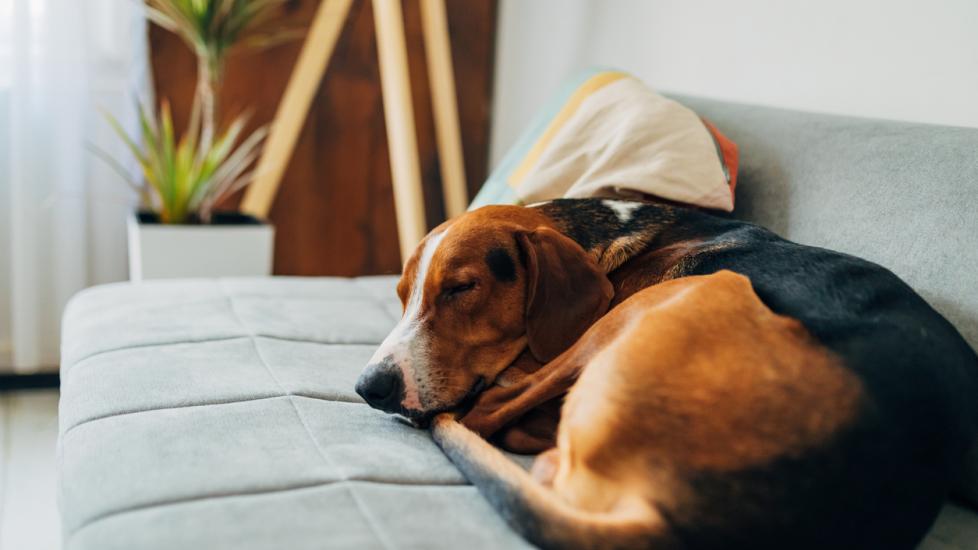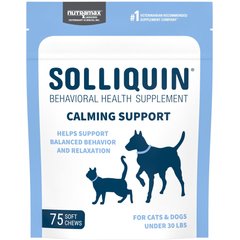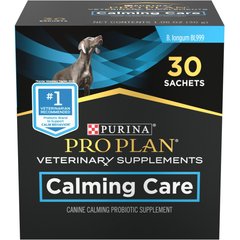10 Ways to Calm Your Dog Naturally
There's nothing more loyal, companionable, or loving than a dog, but dogs can get anxious and stressed just like humans.
Learning the best ways to keep a dog calm naturally is important for their health and happiness. Here are some things you can try to calm your furry friend before talking to your veterinarian about a prescription option.
Why Are Dogs Anxious?
Anxiety can be caused by anything from separation anxiety and fear of loud noises to changes in routine and environment. It's common for dogs to show signs of anxiety in the form of:
-
Excessive barking
-
Whining
-
Destructive behavior
-
Panting
-
Pacing
-
Trembling
-
Loss of appetite
-
Trying to hide or escape from the stressful situation
Recognizing these signs of anxiety is crucial to ensuring you give your pet the best care possible.
Tips for Calming Your Dog Naturally
1. Create and Maintain a Consistent Schedule
It's essential to establish a routine for your dog so they feel comfortable and secure. Dogs are creatures of habit and thrive on predictability and structure. Feeding times, exercise times, playtimes, and sleep times are all part of a routine.
Stay consistent as much as possible so your dog doesn't get confused or stressed. Small changes in a schedule can trigger stress. Maintaining a regular feeding schedule and exercising your dog regularly will keep them healthy and mentally stimulated. Giving your dog a set bedtime will also ensure they get a good night's sleep.
2. Play Music or White Noise
When dogs experience anxiety, music or white noise can help calm them down. This provides a soothing and calming environment, and it can naturally reduce their stress and anxiety levels. White noise or music can also drown out the unpredictable noises from thunderstorms or fireworks that trigger anxiety.
Luckily, many apps and playlists are specifically curated to calm and soothe dogs. Music therapy helps reduce barking by distracting the dog from the triggers that make your pet bark. Relaxation and comfort can be achieved by using music or white noise, both of which provide a calming environment.
3. Dress Them in a Thundershirt
Thundershirts® are garments that help dogs cope with many types of stressful situations, including thunderstorms, car rides, trips to the veterinarian, or fireworks. A Thundershirt® works by gently applying pressure to your dog's body, which can make them feel hugged and soothe any anxieties. As a result of this pressure, the dog stays calm in situations that would normally distress them, similar to the way humans use a weighted blanket.
Recommended Products
4. Exercise And Playtime Are Important
Playtime and exercise are essential for a dog's mental and physical health. In addition to burning off excess energy, regular exercise releases endorphins, which reduce anxiety and stress in dogs.
You and your pup can enjoy many activities together, like walking, playing fetch, tug-of-war, or running around the backyard. Participating in these activities with your dog will benefit them not only physically, but also mentally.
5. Keep Your Dog Mentally Stimulated
Physical exercise isn't the only thing dogs need. To prevent boredom and anxiety, keep your pup's mind active and engaged.
Mental stimulation can be provided by using puzzle toys and training sessions. Dogs can learn new tricks and cues and use their problem-solving skills through these methods. Playing with other dogs and engaging in interactive play with their pet parents can also help stimulate your dog’s mind.
6. Try Pheromones
Dogs communicate with each other by releasing pheromones. These chemicals are released to show dominance, submission, or to attract a mate. When dogs are in a new environment, or are feeling anxious, synthetic pheromones like Adaptil® can help calm them down. In addition to diffusers, sprays, and collars, Adaptil is available in a variety of forms.
7. Groom Your Dog
Natural ways to calm your dog can even include grooming. Regular grooming keeps your dog clean and healthy, and it gives you and your furry friend a bonding experience. The act of brushing your dog's coat releases endorphins that reduce stress and promote relaxation.
8. Give Them Natural Supplements
It's also possible to calm your dog with natural supplements. Popular supplements include:
Always chat with your veterinarian first to determine the best supplement based on your dog’s health history.
Recommended Products
9. Use Desensitization Techniques
To help your dog overcome fears and anxieties, desensitization techniques can be used. In a controlled and positive environment, gradually expose your dog to the stimulus that's giving them anxiety. You can play a recording of a low-level noise at first, and gradually increase the volume if your dog's afraid of loud noises.
You can use counterconditioning, which associates the source of anxiety with positive experiences, and systematic desensitization, which gradually exposes your dog to anxiety while providing relaxation techniques. It’s important to work with your veterinarian or behaviorist to ensure you approach this desensitization in a safe manner for your pup.
10. Discuss Next Steps with Your Veterinarian
A holistic plan for calming your dog naturally should be developed with your veterinarian if your pup shows signs of stress and anxiety. Other treatments your veterinarian might recommend are behavior modification therapy, prescription medication, or referral to a veterinary behaviorist. Seeking advice from your veterinarian can help you decide which natural calming techniques are best for your dog.
Keep in mind that every dog is unique, so it's important to remember what works for one dog may not work for another. If you are concerned about the anxiety level of your dog, always consult a veterinarian.
Featured Image: iStock.com/Kosamtu




